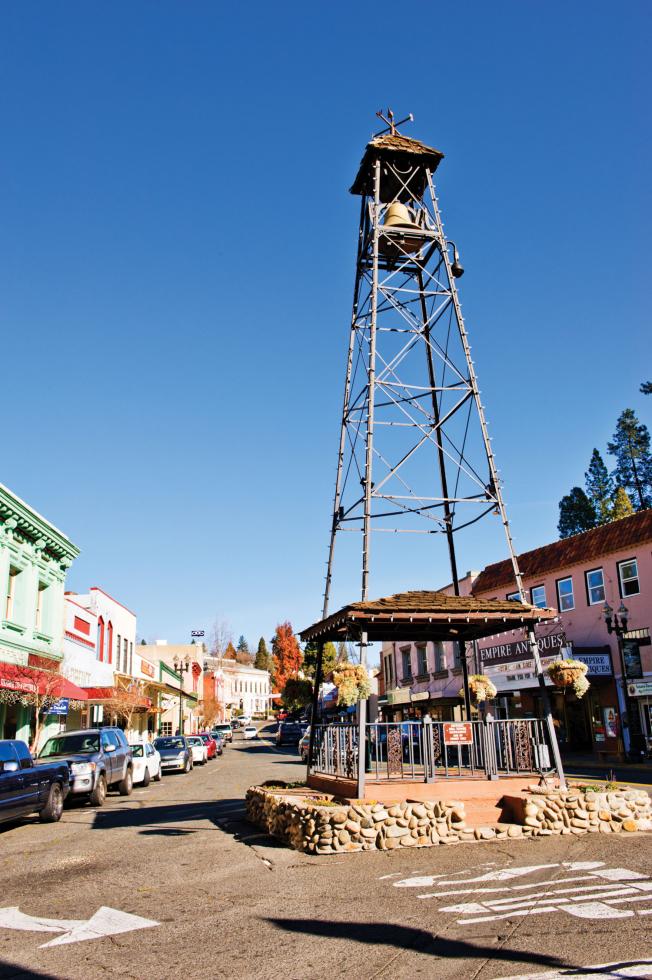Historic Main Street, Placerville
(istockphoto.com)

Say what you will about the severity of state and federal budget woes, but it’s arguably the small towns that are bearing the real brunt of today’s economy.
Here in Northern California where the real estate collapse hit hardest, towns that once relied on building permit fees and retail sales taxes were suddenly clamoring for new revenue sources. For many, redevelopment was a pathway of promise, until 2011, when state legislation abolished redevelopment agencies. Bank accounts seeded with redevelopment funds evaporated along with any chance to parlay those funds into new tax revenues, jobs and other benefits. When the State Supreme Court upheld the legislation, it was a death knell for towns’ hopes of growing their way out of the downturn.
Piling on, small towns also face competition from the global marketplace. Today’s consumers want deals, and they’re finding them online, where getting to stores doesn’t burn pricey gasoline and where sellers can undercut prices, luring ever scarcer dollars away from brick-and-mortar merchants on Main Street.
Still, budget constraints pressing small towns have forced them to operate more efficiently as residents expect the same levels of service and support they’ve always enjoyed.
Cities have come to terms with the fact that the glory days of the mid-2000s are gone, possibly for good. That’s inspired many towns to take a hard look at who and what they are. They’re figuring out how to focus on strengths and how to turn obstacles into assets, and it’s making them more optimistic. Many leaders say they’re going to be well positioned for the recovery they all believe is coming. Indeed, with some already experiencing increases in building permit applications and tax revenues, microscopic though they are, there’s even hope a rebound may have begun.
Ultimately, the circumstances facing small towns and their approaches to recovery are as varied as the jurisdictions themselves. Five towns in the Capital Region, however, provide an assorted look at the recession’s impacts, how smart leaders responded and why visions for the future are legitimately positive.
Woodland
All of Woodland’s major economic indicators were down already when the abolition of redevelopment agencies struck. Its double-digit unemployment rate was one of the highest in California, tax revenues were down to levels not seen since 2000 and building permits were a tragedy, down from 400 annually to fewer than 20.
One of Woodland’s greatest assets is its historic downtown, so when the new redevelopment law hit, it could not have come at a worse time.
“We have this wonderful historic downtown. It’s one of the reasons people come here, and we lost our tool to redevelop it,” says Wendy Ross, Woodland’s economic development manager. “That was a hit of about $1.2 million annually.”
That’s not to say the town is paralyzed. Even without redevelopment funds, tax revenues are showing slight increases, and unemployment is incrementally lower now than at the start of 2012, due in part to the city providing access to education and training. More promising, however, are the aggressive steps Woodland has taken to establish a much stronger position in the coming years.
On the administrative level, town leaders took many of the same steps as other communities to reduce costs while maintaining basic services. Departments were consolidated, vacated job positions remained closed, hours of operation were reduced, city parks and pools were closed and some services were farmed out to private contractors. The city was also one of the first to reduce fees and expand its over-the-counter offerings in order to streamline services.
Beyond the administrative changes, however, what makes Woodland’s prospects look good is its decision to shore up its foundations.
“Without agriculture, there’d be no Woodland,” Ross says. “The economy has forced us to determine what we are, and we are agriculture, from growing, to processing, equipment and other factors. We can market that strength. If anyone’s in agriculture, they should be here.”
That’s not to the exclusion of downtown, of course, which is one of the city’s other strengths and one useful for marketing Woodland as a destination. To that end, the city is updating its general plan, something it hasn’t done in more than 20 years.
Marysville
Even in good economic years, it’s tough being a town that has no room to grow.
“Marysville is encircled by rivers and levees,” says Walter Munchheimer, Marysville’s city manager. “It’s a gold rush town that thrived in its early days, but we’ve been at full build-out for a long time and that colors everything about the challenges we face.”
Given its unique circumstances, infill and redevelopment has long been a core strategy for economic growth. When state law obliterated the town’s redevelopment agency, it left two things in place: whatever money was left in the redevelopment agency’s account and whatever financial obligations the agency still had outstanding.
In an ordinary world, the remaining assets could have been used to pay off the obligations, but towns must get state approval to do that. If they are “disallowed,” the municipality must pay the obligations from its own pocket. Since every redevelopment dollar the state allows cities to use is one less dollar it can take for its own purposes, the outcomes to date have been fairly predictable.
“Colleagues in other cities are saying the state is disallowing a large percentage of these obligations, so my hunch is we’ll have our share of disallowed obligations too,” Munchheimer says. “If those obligations fall to the city, it would be terrible for our financial situation.”
That situation is one characterized by a third year of salary and benefit cuts, ongoing hiring and purchasing freezes, tough competition for retail dollars from Yuba City (which has all the malls and chain stores) and a reliance on grants to maintain funding at traditional levels. The good news is that sales taxes, perhaps the city’s single most important economic indicator, are actually up, albeit an anemic 0.6 percent over last year. That’s still better than negative, although bad news may be on the horizon.
“We’ve got two car dealerships, both of which are among our top five sales tax generators, and both are relocating to Yuba City,” Munchheimer says. “We’ve traditionally had a fairly narrow retail base to draw on. In good economic times we got along okay without it, but it became a hard reality when the economy collapsed.”
In response, city leaders realize optimism isn’t enough, and they are developing a new vision referred to as the “Bounceback Initiative.” It’s based on the understanding that, because of the city’s historic and topographic constraints, it doesn’t have the growth path to prosperity other cities have. Munchheimer says the plan is likely to involve capitalizing on the town’s current assets and making those more attractive to the 2.5 million people who live within a 50-mile radius.
The plan is also looking at ways to turn the economic inhibitors, i.e. the proximity of the Feather and Yuba rivers, into economic contributors.
“We’re hemmed in by a wide inundation zone, which makes it hard to capitalize on the land there,” Munchheimer says. “It’s unquestionably hard to develop, but it’s also undeniably underutilized.”
Placerville
Somewhere between the golden days of 2006 and the end of 2010, Placerville experienced an almost perfect storm. Sales tax revenues — the city’s bread and butter — dropped nearly 30 percent while operating expenses rose sharply. Construction permits dropped by almost 25 percent, and building-related fee revenue tanked more than 60 percent. Highlighting the problem, Lumsden Ranch, a 133-acre development with 366 homes, died before a single stake went in the ground.
The loss of a Ford dealership and the termination of the city’s redevelopment agency only exacerbated the pain, as did another state law requiring municipalities to upgrade their sewer plants. That forced Placerville to take on a $42 million loan in order to meet new standards.
Like many cities in similar situations, town leaders looked at administrative stopgaps to balance the budget. Nothing was immune to cuts. Services were reduced to the most vital, communications went almost exclusively online, furloughs were implemented, departments were reorganized and consolidated, benefits were modified and a 10-percent pay cut was administered across the board. Even the subsidy to the community-sponsored swim team was eliminated. Open positions were frozen as employees took early retirement offers, and layoffs were eventually announced. Grant funding that had been sought to add new positions was suddenly critical just to keeping current jobs in place.
“I couldn’t tell you about the steps we had to take without calling out how cooperative our employees and their unions were in working with us,’ says Dave Warren, Placerville’s Finance Director. “They’ve been really supportive and have continued to do great work for our residents under some tough circumstances.”
Without a redevelopment agency to fund refurbishment of the town’s 160-year-old infrastructure (and in so doing, attract new development) the city had to find alternatives. Fortunately, one was already in place due to the passage of Measure H in late 2010, which added a quarter-cent to the sales tax to fund infrastructure and redevelopment improvements.
As another novel step, the City Council established an advisory committee at the start of 2012 to assist the city in developing a long-term economic development strategy. It’s still somewhat nascent, but as has been the case in other cities, there’s a focus on playing to the city’s strength.
“We are a retail market. I don’t see that changing,” says City Manager Cleve Morris. “Nor do I think 2007 is coming back any time soon. This is the new normal. But we’re seeing encouraging signs, and we have some real opportunities to keep our future bright.”
Indeed, the past seven quarters have seen consecutive increases in sales tax revenues, meaning the passage of Measure H is on pace to add $800,000 to the city’s coffers this year. It’s still a long road back to prosperity, but city leaders are happy to be on it.
Citrus Heights
Like every other jurisdiction, Citrus Heights has done some belt tightening, but it’s one of the few small towns that finished every year since 2006 in the black.
“We’ve been conservative in our budgeting, and while we’ve had to make cuts, we haven’t had any layoffs,” says Ronda Sherman, Citrus Heights’ community and economic development director.
As something of a retail hub, Citrus Heights did see sales tax revenues dip by $2.5 million between 2006 and 2009. Since then, the numbers have started to climb back, but they’ve only filled about 20 percent of the hole as Citrus Heights has faced the positives and negatives of being almost built out. On the one hand, it has the rooftops and population density to attract retailers. On the other, with no new land available, it’s hard for aging facilities and infrastructure to compete with the greenfields available in places like Folsom and Roseville.
“When we lost our redevelopment agency, we lost one of our biggest economic development tools, so we’ve had to look at other ways to attract new business,” Sherman says.
In 2011, as the redevelopment agency was slipping away, the city started the process of updating its 12-year-old economic development plan. The result was four strategies that are now being explored:
-
diversifying the economic base to include more non-retail businesses
-
helping existing retailers adapt to the changing marketplace
-
nurturing small businesses, especially the city’s numerous home-based businesses
-
developing and implementing a strategy to promote all the city has to offer.
The strategy includes ideas for everything from a revolving loan program to fee deferrals, sales tax sharing and an economic development investment fund, all currently being considered by the City Council.
Longer term, there may also be a windfall on the far horizon. As part of its cityhood agreement with Sacramento County, Citrus Heights will begin collecting property taxes in 2022.
Galt
This past September, Galt issued its first single-family-dwelling building permit since 2009. It was only for one unit, but it was the start of what leaders hope will be a trend. “Developers are starting to come out of hiding,” says Jason Behrmann, Galt’s city manager. “We just approved a tentative subdivision map for 100 units, a second subdivision project is starting its planning stages and we’re getting a Walmart in 2013. We’re hopeful we’ll see a slow but measurable turnaround in the near future.”
Development aside, Galt has weathered the downturn remarkably well in comparison to other small towns. In 2008, the city passed Measure 8, a half-cent sales tax, which has funded public safety well enough to avoid even a single cut in the police force.
That’s not to say there haven’t been reductions — the city’s workforce has shrunk 15 percent since 2006 — or that the city has been immune to the economy or the need for drastic actions to balance the budget. When things hit bottom, Galt was staring into a $1 million structural deficit on a $10 million general fund budget. The difference, however, was preparation.
“We’d built up a reserve by putting money away prior to the downturn, rather than overextending ourselves,” Behrmann says. “We were able to rely on that reserve and last year finished in the black for the first time since 2008. Having a reserve bought us time to balance revenues and costs, and it’s left us on solid footing.”
The city also has the 30-year-old Galt Market, a flea market it owns and operates. As consumers hunt for deals, the flea market has continued to perform well, bringing about $1.5 million in tax revenues annually.
With a population hovering near 25,000, city leaders know major retailers are likely to look to more populated areas first, so they’re not relying on sales taxes or developer fees. Instead, Galt generates revenue from transient occupancy taxes, license fees and other sources.
Redevelopment funds vanished here as elsewhere and hit the city’s operational and project plans hard, but leaders are focused on finding new ways to revitalize downtown and attract new restaurants and shops and even a movie theater. The goal is to keep people local.
“Our residents are driving to a lot of other communities and taking their money with them when they shop and dine,” Behrmann says. “The more we can keep people in town, and even start attracting people from outside the area, the more we can keep that money here.”
Recommended For You

Striking Oil
In Woodland, La Tourangelle cracks the nut oil market
Pulling up to the bland business park that is home to La Tourangelle’s nut oil bottling facility gives no indication of the nexus of culinary artistry housed inside.
But step through the doors and start talking to Matthieu Kohlmeyer, the energetic founder and CEO of the Woodland company, and you’ll discover that this quiet farming town is home to a vibrant French connection and a business that’s ridden the wave of consumer health trends and successfully plugged into the farm-to-fork movement.

Industrial Reinvention
Woodland finds new uses for old buildings
When West Sacramento-based Clark Pacific went shopping for a third location to expand its precast concrete business, it found a home with a familiar name: the former Spreckels Sugar Mill, just outside Woodland.


